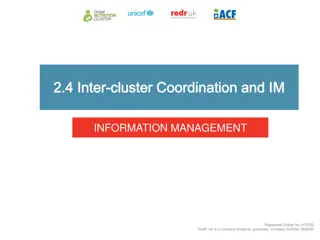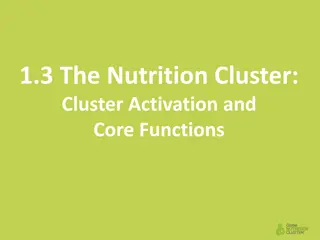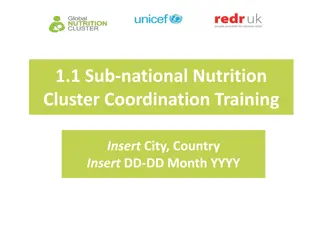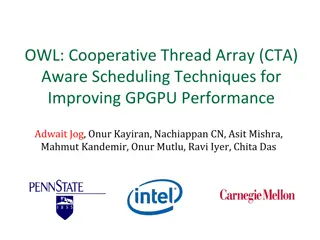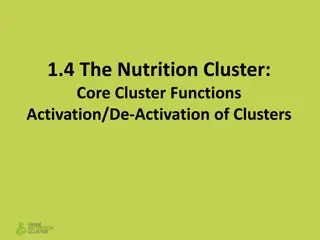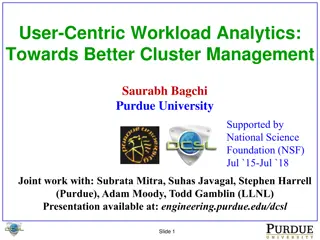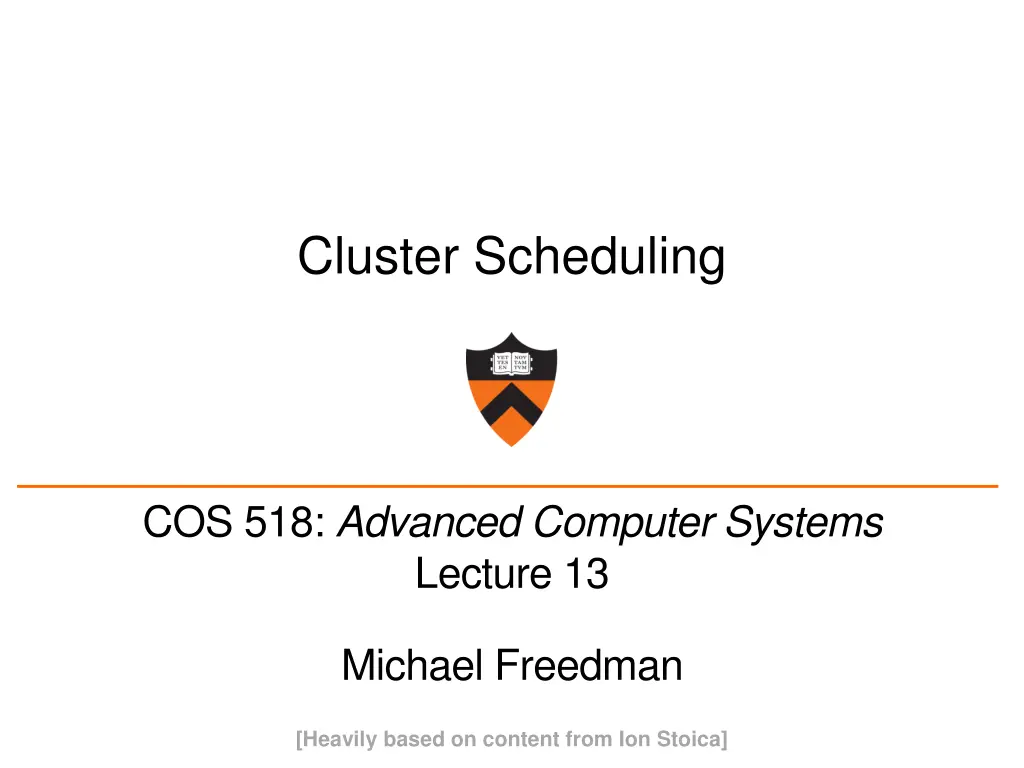
Advanced Cloud Computing Systems and Resource Scheduling
Explore key aspects of cloud computing, resource demand elasticity, and strategies for fuller utilization. Learn about the importance of scheduling in CPU and bandwidth allocation, and the criteria for an effective scheduler.
Download Presentation

Please find below an Image/Link to download the presentation.
The content on the website is provided AS IS for your information and personal use only. It may not be sold, licensed, or shared on other websites without obtaining consent from the author. If you encounter any issues during the download, it is possible that the publisher has removed the file from their server.
You are allowed to download the files provided on this website for personal or commercial use, subject to the condition that they are used lawfully. All files are the property of their respective owners.
The content on the website is provided AS IS for your information and personal use only. It may not be sold, licensed, or shared on other websites without obtaining consent from the author.
E N D
Presentation Transcript
Cluster Scheduling COS 518: Advanced Computer Systems Lecture 13 Michael Freedman [Heavily based on content from Ion Stoica]
Key aspects of cloud computing 1. Illusion of infinite computing resources available on demand, eliminating need for up-front provisioning 2. The elimination of an up-front commitment 3. The ability to pay for use of computing resources on a short-term basis From Above the Clouds: A Berkeley View of Cloud Computing 2
Two main sources of resource demand Services External demand, scale supply to match demand Data analysis Tradeoff scale & completion time E.g., use 1 server for 10 hours vs. 10 servers for 1 hour Source of demand elasticity! Type of contract Spot - 1 hr duration Spot 6 hr duration On-demand Price (m4.xlarge) $0.139 / hour $0.176 / hour $0.215 / hour 3
Towards fuller utilization Source of variable demand? Search, social networks, e-commerce, usage have diurnal patterns Apocryphal story: AWS exists because Amazon needed to provision for holiday shopping season, wanted to monetize spare capacity But if provision for peak, what around remaining time? Fill-in with non-time-sensitive usage, e.g., various data crunching E.g., Netflix using AWS at night for video transcoding 4
Todays lecture Metrics / goals for scheduling resources System architecture for big-data scheduling 5
Scheduling: An old problem CPU allocation Multiple processors want to execute, OS selects one to run for some amount of time Bandwidth allocation Packets from multiple incoming queue want to be transmitted out some link, switch chooses one 6
What do we want from a scheduler? Isolation Have some sort of guarantee that misbehaved processes cannot affect me too much Efficient resource usage Resource is not idle while there is process whose demand is not fully satisfied Work conservation -- not achieved by hard allocations Flexibility Can express some sort of priorities, e.g., strict or time based 7
Single Single Resource Resource: Fair : Fair Sharing Sharing CPU 100% 33% n users want to share a resource (e.g. CPU) Solution: give each 1/n of the shared resource 33% 50% 33% 0% Generalized by max-min fairness Handles if a user wants less than its fair share E.g. user 1 wants no more than 20% Work conserving or work preserving No unused capacity if there s demand. 100% 20% 40% 50% 40% 0% 100% Generalized by weighted max-min fairness Give weights to users according to importance User 1 gets weight 1, user 2 weight 2 33% 50% 66% 0% 8
Max Max- -Min Min Fairness Fairness is Powerful is Powerful Weighted Fair Sharing / Proportional Shares User u1 gets weight 2, u2 weight 1 Priorities: Give u1 weight 1000, u2 weight 1 Reservations Ensure u1 gets 10%: Give u1 weight 10, sum weights 100 Deadline-based scheduling Given a job s demand and deadline, compute user s reservation / weight Isolation: Users cannot affect others beyond their share 9
Max-min Fairness via Fair Queuing Fair queuing explained in a fluid flow system: reduces to bit-by-bit round robin among flows Each flow receives min( ri, f ), where ri flow arrival rate f link fair rate (see next slide) Weighted Fair Queuing (WFQ) Associate a weight with each flow 10
Fair Rate Computation If link congested, compute f such that i f = 4: , f)=C min(ri min(8, 4) = 4 8 6 2 10 min(6, 4) = 4 4 4 2 min(2, 4) = 2 11
Fair Rate Computation Associate a weight wiwith each flow i If link congested, compute f such that i f = 2: , f wi)=C min(ri min(8, 2*3) = 6 (w1 = 3) (w2 = 1) (w3 = 1) 8 6 2 10 min(6, 2*1) = 2 6 2 2 min(2, 2*1) = 2 12
Theoretical Properties of Max-Min Fairness Share guarantee Each user gets at least 1/n of the resource But will get less if her demand is less Strategy-proof Users are not better off by asking for more than they need Users have no reason to lie 13
Why is Max-Min Fairness Not Enough? Job scheduling is not only about a single resource Tasks consume CPU, memory, network and disk I/O What are task demands today? 14
Heterogeneous Heterogeneous Resource Resource Demands Demands Some tasks are CPU-intensive Some tasks are memory-intensive Most task need ~ <2 CPU, 2 GB RAM> 2000-node Hadoop Cluster at Facebook (Oct 2010) 15
How How to to allocate allocate? ? 2 resources: CPUs & memory 100% 100% User 1 wants <1 CPU, 4 GB> per task ? ? ? ? 50% 50% User 2 wants <3 CPU, 1 GB> per task 0% 0% CPU CPU mem mem What s a fair allocation? 16
A Natural Policy Asset Fairness: Equalize each user s sum of resource shares 100% 100% Cluster with 28 CPUs, 56 GB RAM 43% 43% 43% 43% U1 needs <1 CPU, 2 GB RAM> per task, or <3.6% CPUs, 3.6% RAM> per task 50% 50% 57 57% % 28% 28% U2 needs <1 CPU, 4 GB RAM> per task, or <3.6% CPUs, 7.2% RAM> per task 0% 0% CPU CPU RAM RAM User 1 User 1 User 2 User 2 Asset fairness yields U1: 12 tasks: <43% CPUs, 43% RAM> ( =86%) U2: 8 tasks: <28% CPUs, 57% RAM> ( =86%) 17
Strawman for asset fairness Approach: Equalize each user s sum of resource shares 100% 100% Cluster with 28 CPUs, 56 GB RAM 43% 43% 43% 43% U1 needs <1 CPU, 2 GB RAM> per task, or <3.6% CPUs, 3.6% RAM> per task Problem: violates share guarantee User 1 has < 50% of both CPUs and RAM 50% 50% 57 57% % 28% 28% U2 needs <1 CPU, 4 GB RAM> per task, or <3.6% CPUs, 7.2% RAM> per task Better off in separate cluster with half the resources 0% 0% CPU CPU RAM RAM User 1 User 1 User 2 User 2 Asset fairness yields U1: 12 tasks: <43% CPUs, 43% RAM> ( =86%) U2: 8 tasks: <28% CPUs, 57% RAM> ( =86%) 18
Cheating Cheating the the Scheduler Scheduler Users willing to game the system to get more resources Real-life examples A cloud provider had quotas on map and reduce slots Some users found out that the map-quota was low. Users implemented maps in the reduce slots! A search company provided dedicated machines to users that could ensure certain level of utilization (e.g. 80%). Users used busy-loops to inflate utilization. How achieve share guarantee + strategy proofness for sharing? Generalize max-min fairness to multiple resources/ 19
Dominant Resource Fairness (DRF) Dominant Resource Fairness (DRF) A user s dominant resource is resource user has biggest share of Example: Total resources: User 1 s allocation: 8 CPU 2 CPU 5 GB 1 GB 20% RAM 25% CPUs Dominant resource of User 1 is CPU (as 25% > 20%) A user s dominant share: fraction of dominant resource allocated User 1 s dominant share is 25% Dominant Resource Fairness: Fair Allocation of Multiple Resource Types Ali Ghodsi, Matei Zaharia, Benjamin Hindman, Andy Konwinski, Scott Shenker, Ion Stoica, NSDI 1120
Dominant Dominant Resource Resource Fairness Fairness (DRF) (DRF) Apply max-min fairness to dominant shares Equalize the dominant share of the users. Example: Total resources: <9 CPU, 18 GB> User 1 demand: <1 CPU, 4 GB>; dom res: mem (1/9 < 4/18) User 2 demand: <3 CPU, 1 GB>; dom res: CPU (3/9 > 1/18) 100% User 1 User 2 12 GB 66% 3 CPUs 50% 66% 6 CPUs 2 GB 0% CPU (9 total) mem (18 total) 21
Online DRF Online DRF Scheduler Scheduler Whenever available resources and tasks to run: Schedule task to user with smallest dominant share 22
Todays lecture 1. Metrics / goals for scheduling resources 2. System architecture for big-data scheduling 23
Many Competing Frameworks Many different Big Data frameworks Hadoop | Spark Storm | Spark Streaming | Flink GraphLab MPI Heterogeneity will rule No single framework optimal for all applications So each framework runs on dedicated cluster? 24
One Framework Per Cluster Challenges Inefficient resource usage E.g., Hadoop cannot use underutilized resources from Spark Not work conserving Hard to share data Copy or access remotely, expensive Hard to cooperate E.g., Not easy for Spark to use graphs generated by Hadoop 25
Common resource sharing layer ? Abstracts ( virtualizes ) resources to frameworks Enable diverse frameworks to share cluster Make it easier to develop and deploy new frameworks Hadoop Spark Spark Hadoop Resource Management System Multiprograming Uniprograming 26
Abstraction hierarchy 101 In a cluster: a framework(e.g., Hadoop, Spark) manages 1+ jobs a job consists of 1+ tasks a task(e.g., map, reduce) involves 1+ processes executing on single machine Executor (e.g., Task Tracker) task 5 Executor (e.g., Task Traker) task 6 Job 1:tasks 1, 2, 3, 4 Job 2: tasks 5, 6, 7 task 1 task 2 Framework Scheduler (e.g., Job Tracker) Executor (e.g., Task Tracker) task 7 Executor (e.g., Task Tracker) task 4 task 3 27
Abstraction hierarchy 101 In a cluster: a framework(e.g., Hadoop, Spark) manages 1+ jobs a job consists of 1+ tasks a task(e.g., map, reduce) involves 1+ processes executing on single machine Seek fine-grained resource sharing Tasks typically short: median ~= 10 sec minutes Better data locality / failure-recovery if tasks fine-grained 28
Approach #1: Global scheduler Global scheduler takes input, outputs task schedule Organization policies Resource Availability Estimates: Task durations, input sizes, xfer sizes, Job requirements: Latency, throughput, availability Job execution plan: Task DAG, inputs/outups Advantages: Optimal Disadvantages More complex, harder to scale (yet Google: 10,000s servers/scheduler) Anticipate future requirements, refactor existing 29
Googles Borg Centralized Borgmaster + Localized Borglet (manage/monitor tasks) Goal: Find machines for a given job job hello = { runtime = { cell = ic } binary = ../hello_webserver args = { port = %port% } requirements = { RAM = 100M disk = 100M CPU = 0.1 } replicas = 10000 } Large-scale cluster management at Google with Borg A. Verma, L. Pedrosa, M. Korupolu, D. Oppenheimer, E. Tune, J. Wilkes, EuroSys 15 30
Googles Borg Centralized Borgmaster + Localized Borglet (manage/monitor tasks) Goal: Find machines for a given job Used across all Google services Services: Gmail, web search, GFS Analytics: MapReduce, streaming Framework controller sends master allocation request to Borg for full job 31
Googles Borg Centralized Borgmaster + Localized Borglet (manage/monitor tasks) Goal: Find machines for a given job Allocation Minimize # / priority preempted tasks Pick machines already having copy of the task s packages Spread over power/failure domains Mix high/low priority tasks 32
Approach #2: Offers, not schedule Unit of allocation: resource offer Vector of available resources on a node E.g., node1: <1CPU, 1GB>, node2: <4CPU, 16GB> 1. Master sends resource offers to frameworks 2. Frameworks: Select which offers to accept Perform task scheduling Unlike global scheduler, requires another level of support Mesos: A Platform for Fine-Grained Resource Sharing in the Data Center Benjamin Hindman, Andy Konwinski, Matei Zaharia, Ali Ghodsi, Anthony D. Joseph, Randy Katz, Scott Shenker, Ion Stoica, NSDI 11 33
How to allocate resources? DRF! CPU 10 4 (40%) 1 (10%) Memory 20 2 (10%) 5 (25%) Cluster Supply A s Demand B s Demand Cluster: Remaining ( 10cpu, 20gb ) Cluster: Offer (2cpu, 2gb) to A A s Allocation (0cpu, 0gb, 0%) B s Allocation (0cpu, 0gb, 0%) ( 10cpu, 20gb ) (4cpu, 3gb) to A (0cpu, 0gb, 0%) (4cpu, 3gb, 40%) ( 6cpu, 17gb ) (1cpu, 3gb) to B (4cpu, 3gb, 40%) (0cpu, 0gb, 0%) ( 5cpu, 12gb ) (1cpu, 5gb) to B (4cpu, 3gb, 40%) (1cpu, 5gb, 25%) ( 1cpu, 10gb ) (4cpu, 2gb) to A (1cpu, 5gb, 25%) (8cpu, 5gb, 80%) ( 0cpu, 4gb ) (1cpu, 6gb) to B (8cpu, 5gb, 80%) (2cpu, 11gb, 55%) 34
Todays lecture Metrics / goals for scheduling resources Max-min fairness, weighted-fair queuing, DRF System architecture for big-data scheduling Central allocator (Borg), two-level resource offers (Mesos) 35



